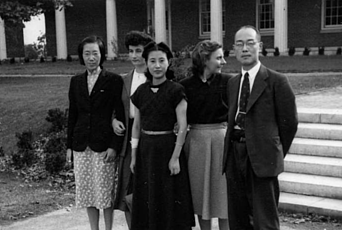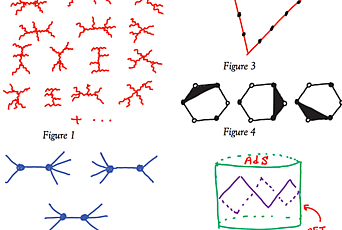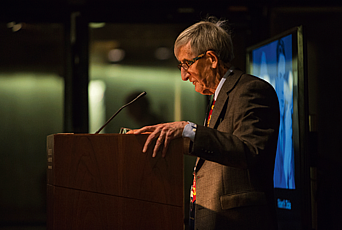Freeman Dyson, Professor Emeritus in the School of Natural Sciences, wrote a series of letters to his parents about Richard Feynman, published by Physics Today in 1989. Feynman visited the Institute but declined an offer to join its Faculty from J. Robert Oppenheimer, Director of the Institute at the time, because he considered the Institute to be “snobbish, stuffy, and scientifically sterile,” according to Dyson (for more on Feynman’s views of the Institute, see his autobiography, Surely You’re Joking, Mr. Feynman!). Dyson mentions Cécile DeWitt-Morette in his letters, excerpts of which are below with Dyson’s commentary in italics.
In the next letter a great woman appears, whose name was then Cécile Morette and is now Cécile DeWitt. She was in 1948 a member of the Institute for Advanced Study, having arrived from France via Dublin and Copenhagen. She was the first of the younger generation to grasp the full scope and power of the Feynman path integral approach to physics. While I was concerned with applying Feynman’s methods to detailed calculations, she was thinking of larger issues, extending the path integral idea to everything in the universe including gravitation and curved space-times.
Boston, 1 November 1948
After my last letter to you I decided that what I needed was a long week-end away from Princeton, and so I persuaded Cécile Morette to come with me to see Feynman at Ithaca. This was a bold step on my part, but it could not have been more successful and the weekend was just deliriously happy. Feynman himself came to meet us at the station, after our l0-hour train journey and was in tremendous form, bubbling over with ideas and stories and entertaining us with performances on Indian drums from New Mexico until 1 a.m.
The next day, Saturday, we spent in conclave discussing physics. Feynman gave a masterly account of his theory, which kept Cécile in fits of laughter and made my talk at Princeton a pale shadow by comparison. He said he had given his copy of my paper to a graduate student to read, then asked the student if he himself ought to read it. The student said “No” and Feynman accordingly wasted no time on it and continued chasing his own ideas. Feynman and I really understand each other; I know that he is the one person in the world who has nothing to learn from what I have written; and he doesn’t mind telling me so. That afternoon, Feynman produced more brilliant ideas per square minute than I have ever seen anywhere before or since. In the evening I mentioned that there were just two problems for which the finiteness of the theory remained to be established; both problems are well-known and feared by physicists.... When I mentioned this fact, Feynman said, “We’ll see about this,” and proceeded to sit down and in two hours, before our eyes, obtain finite and sensible answers to both problems. It was the most amazing piece of lightning calculation I have ever witnessed, and the results prove, apart from some unforeseen complication, the consistency of the whole theory.
The two problems were, the scattering of light by an electric field, and the scattering of light by light....
14 November 1948
Cécile amused us all yesterday by bringing down a French millionaire to see the institute (an industrial magnate of some kind). She said she hinted to him fairly strongly that France could do with an institute of a similar sort; she said if she were made director of the French institute she would invite all of us to come and lecture there. It will be interesting to see if anything comes of it.
The man Cécile brought to see the Princeton institute was Léon Motchane. Motchane later became the founder and first director of the Institut des Hautes Études Scientifiques at Bures-sur-Yvette in France. The IHÉS is a flourishing institution that has made a major contribution to the support of mathematics and theoretical physics in France. Cécile was 26 when she brought Motchane to Princeton and planted the seed that grew into IHÉS. A few years later she founded the Les Houches summer school, which is also a flourishing institution and has been a training ground for generations....



